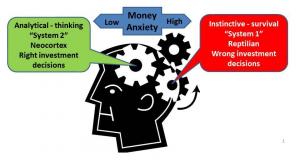Banking could be Facing a Systemic Risk Amid Rising Level of Money Anxiety Says Dr. Dan Geller
A scientific study, presented by Dr. Dan Geller, of Analyticom, to the former Chairman of the FDIC, exposes two major vulnerabilities in the FDIC’s risk models.
When money anxiety increases, the gravity of interest rates decreases, making the traditional Theory of Interest Rates obsolete and a risk to the banking system.”
SAN FRANCISCO, CA, USA, March 20, 2023 /EINPresswire.com/ -- The banking crisis that currently includes a handful of U.S. banks can turn into a system-wide crisis because the FDIC is still using outdated financial economics risk models instead of the newest behavioral economics models developed by the scientific community. The latest such banking study coauthored by Dr. Dan Geller, “Dynamics of Yield Gravity and the Money Anxiety Index,“ shows that when money anxiety is elevated, people start making instinctive/survival decisions, a.k.a System 1, rather than analytical/rational decisions, a.k.a. System 2. — Dr. Dan Geller
The study, which was published in the Journal of Applied Business and Economics, was discussed with the former Chairperson of the FDIC, Jelena McWilliams at the FDIC offices in Arlington, VA. The study’s findings reveal two major vulnerabilities in the banking system. The first finding shows that people hate to lose more than they like to win, which means that when money anxiety is elevated, people will disregard higher interest rates on their deposits in return for the assurance that their money is easily accessible and available for withdrawal at any time.
This finding explains why bank depositors are currently shifting money from small community and regional banks to national banks despite the fact that the average interest rate on deposits is lower at national banks. If the level of money anxiety will continue to increase, it is highly likely that the number of people transferring their deposits to large national banks will grow experientially placing a strain on the required liquidity of smaller banks. Shortfall of liquidity can place any financial institution in a risky position of not meeting the FDIC’s required level of liquidity to support the bank’s loans.
The second systemic risk, which was revealed by the study, is that when the liquidity level of financial institutions is declining, banks and credit unions start increasing their deposit rates in order to attract additional deposits. However, since the ability of interest rate on deposits to attract money is not linear, due to the dynamic impact of money anxiety on people’s decision process, banks and credit unions tend to misprice their deposits. Hence, their interest expense increases and their net interest margins shrink further putting the financial institution at an even greater risk of default.
The study that was presented to the FDIC and its Center for Financial Research uses the Money Anxiety Index as a scientific instrument to measure the level of macro anxiety. This is a unique and innovative financial-confidence index because it is based on what people actually do with their money, such as saving or spending, rather than “confidence” survey that are based on how people feel about the economy. Incorporating the Money Anxiety Index into the risk models of the FDIC will help banking regulators see looming risks to the banking system.
The sooner the FDIC starts incorporating behavioral economics principles into its risk models, the better it will be able to understand and control the early stages of a banking crisis such as we may be facing now. The assumption that financial decisions are always rational and analytical, and that “your deposits are insured” arguments do not work because the part of the brain that is active during elevated level of money anxiety is the Reptilian part of the brain, which is in survival-instinct mode. Thus, analytical/rational arguments are not effective.
About Dr. Dan Geller
Dr. Dan Geller is a behavioral economist and the President of Analyticom LLC, a financial modeling firm specializing in the application of behavioral economics to predictive financial models. Dr. Geller is a pioneer in the research dual-decision process, specifically how people alternate between their instinctive-response mode (a.k.a system 1), and their analytical-response mode (a.k.a. system 2). Dr. Geller’s behavioral economics models are used by financial institutions nationally to predict interest rates, and by investors to project equity prices and rate of return.
Dr. Dan Geller
Analyticom LLC
+1 415-891-3093
drgeller@analyticom.com
Legal Disclaimer:
EIN Presswire provides this news content "as is" without warranty of any kind. We do not accept any responsibility or liability for the accuracy, content, images, videos, licenses, completeness, legality, or reliability of the information contained in this article. If you have any complaints or copyright issues related to this article, kindly contact the author above.



